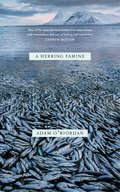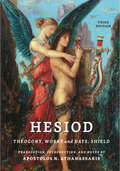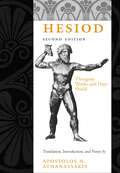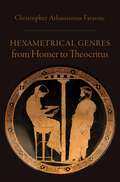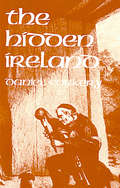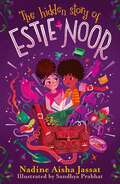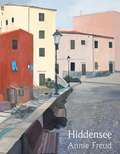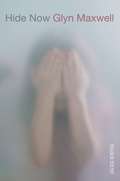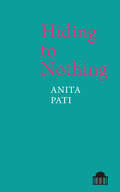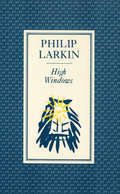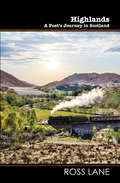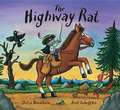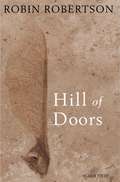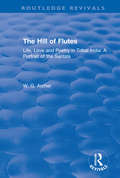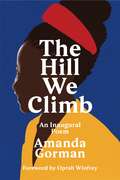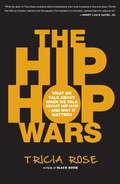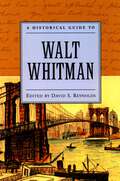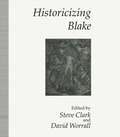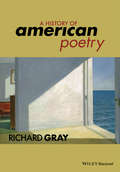- Table View
- List View
A Herring Famine
by Adam O'RiordanThe poems of this dazzling second collection are of contradictory impulses: of abundance and famine, of absence and presence, of endings and new beginnings. Here again are the intelligent, elegant and emotionally potent poems that are O’Riordan’s trademark, yet pushes into bolder territories, from a herring famine of 1907 to the Strangeways Prison Riot of 1990. Bounding place and time, and urging into being both the living and the dead, this crystalline collection captures the struggle, folly and wonder of the human heart.
Hesiod: Theogony, Works and Days, Shield
by Apostolos N. AthanassakisThis best-selling translation of Hesiod's the Theogony, the Works and Days, and the Shield has been updated into the most indispensable edition yet for students of Greek mythology and literature.Next to the works of Homer, Hesiod's poems are foundational texts for students of the classics. His two major surviving works, the Theogony and the Works and Days, address the divine and the mundane, respectively. The Theogony traces the origins of the Greek gods and recounts the events surrounding the crowning of Zeus as their king, while the Works and Days is a manual of moral instruction in verse addressed to farmers and peasants. Though modern scholars dispute the authorship of the Shield, ancient texts treat this final poem about the shield of Herakles as unquestionably Hesiodic.Introducing his celebrated translations of Hesiod, Apostolos N. Athanassakis positions the philosopher-poet as heir to a long tradition of Hellenic poetry. Hesiod's poems demonstrate the author's passionate interest in the governance of human society through justice and a tangible work ethic. As a physicist and a materialist, Hesiod avoided such subjects as honor and the afterlife. His works contain the oldest fundamentals on law and Greek economy, making Hesiod the first great thinker of Western civilization. Athanassakis's contextual notes offer both comparison to Biblical and Norse mythologies as well as anthropological connections to modern Greece.The third edition of this classic undergraduate text includes a thoroughly updated bibliography reflecting the last two decades of scholarship. The introductions and notes have been enriched, clarifying contextual history and the meaning of Hesiod's own language and themes, and notes have been newly added to the Shield. Athanassakis has lightly improved his translation throughout the text, expertly balancing the natural flow of the verse while adhering closely to the literal Greek.
Hesiod: Theogony, Works and Days, Shield
by Apostolos N. AthanassakisThis best-selling translation of Hesiod's the Theogony, the Works and Days, and the Shield has been updated into the most indispensable edition yet for students of Greek mythology and literature.Next to the works of Homer, Hesiod's poems are foundational texts for students of the classics. His two major surviving works, the Theogony and the Works and Days, address the divine and the mundane, respectively. The Theogony traces the origins of the Greek gods and recounts the events surrounding the crowning of Zeus as their king, while the Works and Days is a manual of moral instruction in verse addressed to farmers and peasants. Though modern scholars dispute the authorship of the Shield, ancient texts treat this final poem about the shield of Herakles as unquestionably Hesiodic.Introducing his celebrated translations of Hesiod, Apostolos N. Athanassakis positions the philosopher-poet as heir to a long tradition of Hellenic poetry. Hesiod's poems demonstrate the author's passionate interest in the governance of human society through justice and a tangible work ethic. As a physicist and a materialist, Hesiod avoided such subjects as honor and the afterlife. His works contain the oldest fundamentals on law and Greek economy, making Hesiod the first great thinker of Western civilization. Athanassakis's contextual notes offer both comparison to Biblical and Norse mythologies as well as anthropological connections to modern Greece.The third edition of this classic undergraduate text includes a thoroughly updated bibliography reflecting the last two decades of scholarship. The introductions and notes have been enriched, clarifying contextual history and the meaning of Hesiod's own language and themes, and notes have been newly added to the Shield. Athanassakis has lightly improved his translation throughout the text, expertly balancing the natural flow of the verse while adhering closely to the literal Greek.
Hesiod: Theogony, Works and Days, Shield
by Apostolos N. HesiodHesiod belongs to the transitional period in Greek civilization between the oral tradition and the introduction of a written alphabet. His two major surviving works, the Theogony and the Works and Days, address the divine and the mundane, respectively. The Theogony traces the origins of the Greek gods and recounts the events surrounding the crowning of Zeus as their king. A manual of moral instruction in verse, the Works and Days was addressed to farmers and peasants.Introducing his celebrated translations of these two poems and of the Shield, a very ancient poem of disputed authorship, Apostolos Athanassakis positions Hesiod simultaneously as a philosopher-poet, a bard with deep roots in the culture of his native Boeotia, and the heir to a long tradition of Hellenic poetry. For this eagerly anticipated revised edition, Athanassakis has provided an expanded introduction on Hesiod and his work, subtly amended his faithful translations, significantly augmented the notes and index, and updated the bibliography. Already a classic, Hesiod: Theogony, Works and Days, Shield is now more valuable than ever for students of Greek mythology and literature.
Hexametrical Genres from Homer to Theocritus
by Christopher Athanasious FaraoneIn Hexametrical Genres from Homer to Theocritus, Christopher Faraone discusses a number of short hexametrical genres such as oracles, incantations and laments that do not easily fit the generic models provided by the extant poetry of Hesiod and Homer. In the process, he gives us new insight into their ritual performance, their early history, and how poets from Homer to Theocritus embedded or imitated these genres to enrich their own hexametrical poems--by playing with and sometimes overturning the generic expectations of their audiences or readers. Christopher Faraone combines literary and ritual studies to produce a rich and detailed picture of hexametrical genres performed publicly for gods, such as hymns or laments for Adonis, or other that were performed more privately, such as epithalamia, oracles, or incantations. This volume deals primarily with the recovery of lost or under-appreciated hexametrical genres, which are often left out of modern taxonomies of archaic hexametrical poetry, either because they survive only in fragments or because the earliest evidence for them dates to the classical period.
Hexametrical Genres from Homer to Theocritus
by Christopher Athanasious FaraoneIn Hexametrical Genres from Homer to Theocritus, Christopher Faraone discusses a number of short hexametrical genres such as oracles, incantations and laments that do not easily fit the generic models provided by the extant poetry of Hesiod and Homer. In the process, he gives us new insight into their ritual performance, their early history, and how poets from Homer to Theocritus embedded or imitated these genres to enrich their own hexametrical poems--by playing with and sometimes overturning the generic expectations of their audiences or readers. Christopher Faraone combines literary and ritual studies to produce a rich and detailed picture of hexametrical genres performed publicly for gods, such as hymns or laments for Adonis, or other that were performed more privately, such as epithalamia, oracles, or incantations. This volume deals primarily with the recovery of lost or under-appreciated hexametrical genres, which are often left out of modern taxonomies of archaic hexametrical poetry, either because they survive only in fragments or because the earliest evidence for them dates to the classical period.
The Hidden Ireland – A Study of Gaelic Munster in the Eighteenth Century: A Study Of Gaelic Munster In The Eighteenth Century
by Daniel CorkeryDaniel Corkery’s classic book The Hidden Ireland is a study of Irish language poetry and culture in eighteenth-century Munster. The ‘Hidden Ireland’ of the title is literary Ireland: Corkery’s famous book is an attempt to reclaim Munster’s Irish language poets from the hands of grammarians who read them only for their preposition and participle use and to restore them to their rightful place as vibrant and vital lyricists and visionaries.The Hidden Ireland, an instant classic when first published in 1924, was listed as one of the top 50 most influential Irish books in The Books That Define Ireland by Tom Garvin and Bryan Fanning. The Hidden Ireland was revolutionary in its recognition of the contribution of Irish language poets to Irish culture, a contribution that had previously been minimised or even erased in the Anglo-Irish versions of history that preceded it. Corkery’s groundbreaking study of Irish poetry and culture in eighteenth century Munster is widely acknowledged as having had a profound influence on the shaping of modern Anglo-Irish literature in its foregrounding of the role of the Irish language in literature as a repository of Irishness and a specifically Irish worldview .Daniel Corkery’s The Hidden Ireland (1924), arguing for an Irish cultural revival based on the Gaelic tradition of Munster in the eighteenth century, became almost official dogma after 1924, and led to impassioned debate among Irish writers and academics for decades afterwards, including Sean O’Faolain and Frank O’Connor, Corkery’s rebellious students.Tom Garvin and Bryan Fanning, The Books That Define Ireland (2014)
The Hidden Story of Estie Noor
by Nadine Aisha JassatNo one wanted to hear Estie's side of the story. Now she's on a mission to make sure the truth is heard . . . A page-turning mystery novel in verse about identity, friendship and learning to use your voice, with accessible text and beautiful illustrations throughout. When twelve-year-old Estie is expelled from school, she's sent to stay with her aunt in Scotland over the summer. Even though nobody, not even her mum, asked to hear her side of the story. Estie's determined to keep her barriers up and stick to herself until the holidays are over. But when she comes across an intricately folded paper castle with a secret message written inside - a message from someone desperate to tell their own unbelieved story - a chord is struck, and Estie can't help but follow the clues to the next piece of artwork. Who are these messages from? And what will their secret reveal about the town? In helping to uncover the anonymous artist's truth, Estie just might find the words to tell her own. . .
Hiddensee
by Annie FreudHiddensee represents Annie Freud’s most ambitious work to date, not least because it is a book about ambition and its necessity, the need to go beyond oneself, and to do what one cannot: Freud dives into other ways of thinking, other art forms, the taboos of illness and desire, and – spectacularly – other languages. This ambition has also emboldened Freud to pursue and confront the complex truth of herself: her German Jewish inheritance, her teachers, the remarkable minds of the exiled individuals who raised her – and the exiles she herself then pursued. The book also celebrates the work of the French-language Swiss poet Jacques Tornay, whom Freud identifies as a spiritual brother – and a route back into her own French and symbolist influences. These astonishing and generous versions of Tornay remind us that our voices should not and cannot be uncomplicatedly our own. Hiddensee is named for the Baltic island where Annie Freud’s grandmother spent her summers before the war (and its famous artistic community, whose members included George Grosz and Käthe Kollwitz). In its unselfconscious internationalism and breathtaking cultural range, Hiddensee offers a radically European and multilingual perspective to counter the cultural narrowness and closing borders of the current age, and again confirms Freud as one of our most essential poets.
Hide Now
by Glyn MaxwellIn Hide Now, Glyn Maxwell shows how the times have begun to warp time itself: in the poet’s vision, the past rears up again with its angry ghosts, the present is racked by its martial and climatic nightmares, and the future has already come and gone. All the stories of the earth seem menaced by just one – to which nations cover their eyes and ears, and from which the grown-ups run and hide. Scheherazade, Robespierre, Dick Cheney and the Reverend Jim Jones all have their place here, though the book’s presiding genius is the lonely figure of Cassandra, cursed with knowing the fate of a world that finds her screamingly funny. Glyn Maxwell has established an international reputation as one of the most intelligent and stylishly original English poets since Auden, and he has never written with greater urgency or power. ‘[Maxwell’s] astonishing technical facility can make syllables, vowels and consonants do absolutely anything. His energetic voice riffs through evasively ordinary speech taking on love, politics, comedy and bizarre narratives in brilliantly elaborate syntax and forms’ Independent
Hiding to Nothing (Pavilion Poetry)
by Anita Pati*Shortlisted for the Jhalak Prize 2023 ** Anita Pati’s debut collection, *Hiding to Nothing, explores the destabilising effects of violence, particularly empire’s aftermath, on a psyche. Threaded with internal dialogue, this multi-layered work witnesses how unbelonging can unsettle perceptions of the brown female body within an unwelcoming, even hostile, environment. From ‘exotic’ dodos punished for not being doves to Greenface, on whom blonde girls birth natterjack toads, marginal presences tell their stories. Hiding to Nothing suggests that complex and damaging legacies in all their forms can create shockwaves that reverberate over a lifetime, stopping lives from reaching their full potential. And the trauma experienced through centuries of colonial history continues to be embodied and enacted. These perceptions of body-image and self-worth are picked up in the central documentary sequence, Bloodfruit, which is based on interviews with women. Bloodfruit gives voice to the less heard narratives of infertility and difficult trajectories towards becoming, or not becoming, a ‘mother’. Here, the often-fraught notions of womanhood and motherhood are also shown to feed into ideas on who is able to mother. Pati uses an original, lyrical approach towards the ambiguities and ambivalences that cloud our decisions. Ultimately, ambient aggressions towards our own and other bodies can only be made good by breaking the cycle. Pati unravels compacted pain but those looking for easy answers or redemption will find no compromise here.
Hiding to Nothing (Pavilion Poetry)
by Anita Pati*Shortlisted for the Jhalak Prize 2023 ** Anita Pati’s debut collection, *Hiding to Nothing, explores the destabilising effects of violence, particularly empire’s aftermath, on a psyche. Threaded with internal dialogue, this multi-layered work witnesses how unbelonging can unsettle perceptions of the brown female body within an unwelcoming, even hostile, environment. From ‘exotic’ dodos punished for not being doves to Greenface, on whom blonde girls birth natterjack toads, marginal presences tell their stories. Hiding to Nothing suggests that complex and damaging legacies in all their forms can create shockwaves that reverberate over a lifetime, stopping lives from reaching their full potential. And the trauma experienced through centuries of colonial history continues to be embodied and enacted. These perceptions of body-image and self-worth are picked up in the central documentary sequence, Bloodfruit, which is based on interviews with women. Bloodfruit gives voice to the less heard narratives of infertility and difficult trajectories towards becoming, or not becoming, a ‘mother’. Here, the often-fraught notions of womanhood and motherhood are also shown to feed into ideas on who is able to mother. Pati uses an original, lyrical approach towards the ambiguities and ambivalences that cloud our decisions. Ultimately, ambient aggressions towards our own and other bodies can only be made good by breaking the cycle. Pati unravels compacted pain but those looking for easy answers or redemption will find no compromise here.
High Windows (Faber Pocket Poetry Ser.)
by Philip LarkinWhen Philip Larkin's High Windows first appeared, Kingsley Amis spoke for a large and loyal readership when he wrote: 'Larkin's admirers need only be told that he is as good as ever here, if not slightly better.'Like Betjeman and Hardy, Larkin is a poet who can move a large audience - without betraying the highest artistic standards.The poems in High Windows illustrate Larkin's unrivalled ability to bring lyrical expression to ordinary, urban lives. It is a gift that makes him one of the most truly popular of the twentieth century's poets.
Highlands: A Poet's Journey in Scotland (Wordcatcher Modern Poetry)
by Ross LaneThis poetry collection is fundamentally a poet’s love letter to the Scottish Highlands, its beauty, geography, history and its people. In this book, which celebrates 25 years of travel and exploration of the Highland landscape, the poet has woven a wide ranging thesis, at its face at times a travel guide and memoir of moments, time and places, and at another level, as is the poet’s calling, a more profound and deeper analysis of time, journeys and the evaluation of self. It is a collection from a writer who understands the need to question himself and ponder the answers, as he believes the pathways to growth and personal understanding can be found there. There is no denying the profound impact of the Scottish Highlands on the writer, from his early days and first visits right through to later odysseys through a landscape he has grown to love and has changed with him across the years. Through his descriptions of northern castles, lochs, hills and glens, the poet has found a unique view of the dramatic Highlands of Scotland, and the emotions it creates, and delivers a deep and thoughtful collection of scenic, personal and journeyman poetry. The book clearly highlights a true and enduring love for a people and place, the wonder of unparalleled locations, and a poet’s roaming pilgrimages though a breath-taking land.
The Highway Rat (PDF)
by Julia Donaldson Axel Scheffler"Give me your buns and your biscuits! Give me your chocolate éclairs! For I am the Rat of the highway, and the Rat Thief never shares!" You may have heard of a Highwayman - but what about a Highway Rat? No food is safe from this rascally rodent! He steals clover from a rabbit, and snaffles nuts from a squirrel. He even hijacks his own horse's hay! But when a cunning duck crosses his path, has the Highway Rat met his match? Put your hands up for this rhyming romp from the current Children's Laureate, starring a wickedly loveable baddie who'll steal your grub - and your heart!
Hijas del horror : Rocío Silva Santisteban y Regina José Galindo : mujer, testimonio y violencia en la poesía y la performance
by Bethsabé Huamán AndíaHill of Doors
by Robin RobertsonCharged with strangeness and beauty, Hill of Doors is a haunted and haunting book, where each successive poem seems a shape conjured from the shadows, and where the uncanny is made physically present. The collection sees the return of some familiar members of the Robertson company, including Strindberg – heading, as usual, towards calamity – and the shape-shifter Dionysus. Four loose retellings of stories of the Greek god form pillars for the book, alongside four short Ovid versions. Threaded through these are a series of pieces about the poet’s childhood on the north-east coast, his fascination with the sea and the islands of Scotland. However, the reader will also discover a distinct new note in Robertson’s austere but ravishing poetry: towards the possibility of contentment – a house, a door, a key – finding, at last, a ‘happiness of the hand and heart’. Magisterial in its command and range, indelibly moving and memorable in its speech, Hill of Doors is Robin Robertson’s most powerful book to date.
The Hill of Flutes: Life, Love and Poetry in Tribal India: A Portrait of the Santals (Routledge Revivals)
by W.G. ArcherOriginally published in 1974, The Hill of Flutes, is a descriptive account of the Santals and their poetry in their heartland of the Santal Parganas. The book explores the Santal world view, including approaches to education, love, sex, and marriage. It describes and discusses Santal dances, festivals and ceremonies, and other key events and gatherings, such as annual hunts. Through the close consideration of song and poetry, The Hills of Flutes offers an engaging insight into life in Santal society.
The Hill of Flutes: Life, Love and Poetry in Tribal India: A Portrait of the Santals (Routledge Revivals)
by W.G. ArcherOriginally published in 1974, The Hill of Flutes, is a descriptive account of the Santals and their poetry in their heartland of the Santal Parganas. The book explores the Santal world view, including approaches to education, love, sex, and marriage. It describes and discusses Santal dances, festivals and ceremonies, and other key events and gatherings, such as annual hunts. Through the close consideration of song and poetry, The Hills of Flutes offers an engaging insight into life in Santal society.
The Hill We Climb: An Inaugural Poem
by Amanda GormanAmanda Gorman's powerful and historic poem 'The Hill We Climb,' read at President Joe Biden's inauguration, is now available as a collectible gift edition.'Stunning' CNN 'Dynamic' NPR'Deeply rousing and uplifting' VogueOn 20 January 2021, Amanda Gorman spoke a message of truth and hope to millions.Aged twenty-two, she delivered a poetry reading at the inauguration of US President Joe Biden. Her poem, 'The Hill We Climb', addressed the country and reached across the world: a call for a brave future.This special edition, which includes an enduring foreword by Oprah Winfrey, marks that poem and offers us courage, consolation and the inspiration to make change.'I was profoundly moved as I watched you read your poem 'The Hill We Climb' at last month's Inauguration. The power of your words blew me away' Michelle Obama, TIME'When that young, vibrant, charismatic woman walked to the front of the platform in her bright yellow coat and that magnificent presence, I was thrilled' Hillary Clinton'If the hardest part of an artist's job is to fully and honestly meet the moment, Amanda delivered a master class [at the inauguration]. She spoke truth to power and embodied clear-eyed hope to a weary nation. She revealed us to ourselves' Lin-Manuel Miranda, TIME
The Hip Hop Wars: What We Talk About When We Talk About Hip Hop--and Why It Matters
by Tricia RoseHow hip hop shapes our conversations about race--and how race influences our consideration of hip hop Hip hop is a distinctive form of black art in America-from Tupac to the Pulitzer Prize-winning Kendrick Lamar, hip hop has long given voice to the African American experience. As scholar and cultural critic Tricia Rose argues, hip hop, in fact, has become one of the primary ways we talk about race in the United States. But hip hop is in crisis. For years, the most commercially successful hip hop has become increasingly saturated with caricatures of black gangstas, thugs, pimps, and hos. This both represents and feeds a problem in black American culture. Or does it? In The Hip-Hop Wars, Rose explores the most crucial issues underlying the polarized claims on each side of the debate: Does hip hop cause violence, or merely reflect a violent ghetto culture? Is hip hop sexist, or are its detractors simply anti-sex? Does the portrayal of black culture in hip hop undermine black advancement?A potent exploration of a divisive and important subject, The Hip Hop Wars concludes with a call for the regalvanization of the progressive and creative heart of hip hop. What Rose calls for is not a sanitized vision of the form, but one that more accurately reflects a much richer space of culture, politics, anger, and yes, sex, than the current ubiquitous images in sound and video currently provide.
A Historical Guide To Walt Whitman
by David S. ReynoldsFew authors are so well suited to historical study as Whitman, who is widely considered America's greatest poet. ThisGuidecombines contemporary cultural studies and historical scholarship to illuminate Whitman's diverse contexts. The essays explore dimensions of Whitman's dynamic relationship to working-class politics, race and slavery, sexual mores, the visual arts, and the idea of democracy. The poet who emerges from this volume is no "solitary singer," distanced from his culture, but what he himself called "the age transfigured," fully enmeshed in his times and addressing issues that are still vital today.
Historicizing Blake
by Steve Clark David WorrallHistoricizing Blake puts Blake back into the cultural context of his times. These new essays by both established and younger scholars re-address Blake's contemporary milieu after the neglect of ten years of post-structuralist, reader-orientated, methodology. By employing notions of history wider than the purely 'literary', and featuring an important new essay by the period's foremost subcultural historian, Iain McCalman, Historicizing Blake represents a significant contribution towards the re-historicizing of Romanticism.
A History of American Poetry
by Richard GrayA History of American Poetry presents a comprehensive exploration of the development of American poetic traditions from their pre-Columbian origins to the present day. Offers a detailed and accessible account of the entire range of American poetry Situates the story of American poetry within crucial social and historical contexts, and places individual poets and poems in the relevant intertextual contexts Explores and interprets American poetry in terms of the international positioning and multicultural character of the United States Provides readers with a means to understand the individual works and personalities that helped to shape one of the most significant bodies of literature of the past few centuries
A History of American Poetry
by Richard GrayA History of American Poetry presents a comprehensive exploration of the development of American poetic traditions from their pre-Columbian origins to the present day. Offers a detailed and accessible account of the entire range of American poetry Situates the story of American poetry within crucial social and historical contexts, and places individual poets and poems in the relevant intertextual contexts Explores and interprets American poetry in terms of the international positioning and multicultural character of the United States Provides readers with a means to understand the individual works and personalities that helped to shape one of the most significant bodies of literature of the past few centuries
